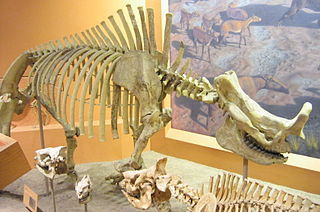
Salamandridae is a family of salamanders consisting of true salamanders and newts. Salamandrids are distinguished from other salamanders by the lack of rib or costal grooves along the sides of their bodies and by their rough skin. Their skin is very granular because of the number of poison glands. They also lack nasolabial grooves. Most species of Salamandridae have moveable eyelids but lack lacrimal glands.

Simplicidentata is a group of mammals that includes the rodents and their closest extinct relatives. The term has historically been used as an alternative to Rodentia, contrasting the rodents with their close relatives the lagomorphs. However, Simplicidentata is now defined as including all members of Glires that share a more recent common ancestor with living rodents than with living lagomorphs. Thus, Simplicidentata is a total group that is more inclusive than Rodentia, a crown group that includes all living rodents, their last common ancestor, and all its descendants. Under this definition, the loss of the second pair of upper incisors is a synapomorphic feature of Simplicidentata. The loss of the second upper premolar (P2) has also been considered as synapomorphic for Simplicidentata, but the primitive simplicidentate Sinomylus does have a P2.

Dunkleosteus is an extinct genus of large arthrodire ("jointed-neck") fish that existed during the Late Devonian period, about 382–358 million years ago. It was a pelagic fish inhabiting open waters, and one of the first vertebrate apex predators of any ecosystem.

Xysticus is a genus of ground crab spiders described by C. L. Koch in 1835, belonging to the order Araneae, family Thomisidae. The genus name is derived from the Ancient Greek root xyst, meaning "scraped, scraper".

Arthrodira is an order of extinct armored, jawed fishes of the class Placodermi that flourished in the Devonian period before their sudden extinction, surviving for about 50 million years and penetrating most marine ecological niches. Arthrodires were the largest and most diverse of all groups of placoderms.

Palaeoniscum is an extinct genus of ray-finned fish from the Permian period (Guadalupian-Lopingian) of England, Germany, Turkey, North America and Greenland, and possibly other regions. The genus was named Palaeoniscum in 1818 by Henri Marie Ducrotay de Blainville, but was later misspelled as Palaeoniscus by Blainville and other authors. Palaeoniscum belongs to the family Palaeoniscidae.

Castianeira is a genus of ant-like corinnid sac spiders first described by Eugen von Keyserling in 1879. They are found in Eurasia, Africa, and the Americas, but are absent from Australia. Twenty-six species are native to North America, and at least twice as many are native to Mexico and Central America.

Lycosa is a genus of wolf spiders distributed throughout most of the world. Sometimes called the "true tarantula", though not closely related to the spiders most commonly called tarantulas today, Lycosa spp. can be distinguished from common wolf spiders by their relatively large size. This genus includes the European Lycosa tarantula, which was once associated with tarantism, a dubious affliction whose symptoms included shaking, cold sweats, and a high fever, asserted to be curable only by the traditional tarantella dance. No scientific substantiation of that myth is known; the venom of Lycosa spiders is generally not harmful.

The Palaeonisciformes, commonly known as "palaeoniscoids" are an extinct grouping of primitive ray-finned fish (Actinopterygii), spanning from the Silurian/Devonian to the Cretaceous. They are generally considered paraphyletic, but their exact relationships to living ray-finned fish are uncertain. While some and perhaps most palaeoniscoids likely belong to the stem-group of Actinopteryii, it has been suggested that some may belong to the crown group, with some of these possibly related to Cladistia and/or Chondrostei. Many palaeoniscoids share a conservative body shape and a similar arrangement of skull bones, though paleoniscoids as a whole exhibit considerable diversity in body shape.

Pardosa is a large genus of wolf spiders, commonly known as the thin-legged wolf spiders. It was first described by C. L. Koch, in 1847, with more than 500 described species that are found in all regions of the world.

Onychodus is a genus of prehistoric lobe-finned fish which lived during the Devonian Period. It is one of the best known of the group of onychodontiform fishes. Scattered fossil teeth of Onychodus were first described from Ohio in 1857 by John Strong Newberry. Other species were found in Australia, England, Norway and Germany showing that it had a widespread range.
The Irdin Manha Formation is a geological formation from the Eocene located in Inner Mongolia, China, a few kilometres south of the Mongolian border.

Palaeoniscidae is an extinct family of "palaeoniscoid" ray-finned fishes (Actinopterygii). The family includes the genus Palaeoniscum and potentially other Palaeozoic and Mesozoic early actinopterygian genera. The name is derived from the Ancient Greek words παλαιός and ὀνίσκος.

Brontotheriidae is a family of extinct mammals belonging to the order Perissodactyla, the order that includes horses, rhinoceroses, and tapirs. Superficially, they looked rather like rhinos with some developing bony nose horns, and were some of the earliest mammals to have evolved large body sizes of several tonnes. They lived around 56–34 million years ago, until the very close of the Eocene. Brontotheres had a Holarctic distribution, with the exception of Western Europe: they occupied North America, Asia, and Eastern Europe. They were the first fossilized mammals to be discovered west of the Mississippi, and were first discovered in South Dakota.

Oxyopes is a genus of lynx spiders found worldwide. It includes arounds 300 species and is classified under the lynx spider family Oxyopidae. Like other lynx spiders, they are easily recognizable by the six larger eyes arranged hexagonally on top of the head (prosoma), with the remaining smaller two eyes in front. They are also characterized by long spine-like bristles (setae) on their legs. They are ambush predators, actively hunting prey by sight. Though they produce and use silk, they do not build webs to capture prey.

Trachelas is a genus of araneomorph spiders which has variously been placed in families Trachelidae or Corinnidae. Current taxonomy places it in Trachelidae.















